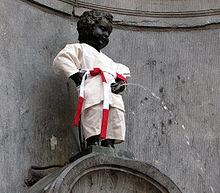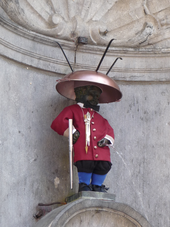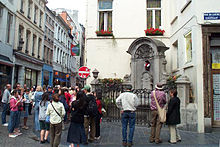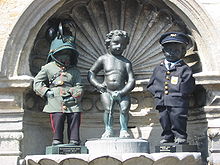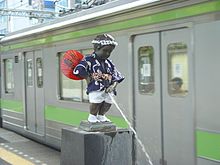- Manneken Pis
-
Coordinates: 50°50′42″N 4°21′00″E / 50.845°N 4.35°E
Manneken Pis 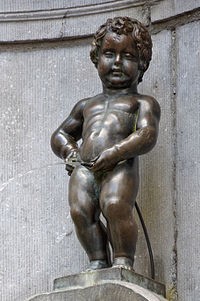
Artist Jerome Duquesnoy Year 1388: original version
1619: current versionType Bronze Dimensions 61 cm (24 in) Location Brussels  Manneken Pis (help·info) (literally Little Man Pee in Marols, a Dutch dialect spoken in Brussels, also known in French as le Petit Julien), is a famous Brussels landmark. It is a small bronze fountain sculpture depicting a naked little boy urinating into the fountain's basin. It was designed by Jerome Duquesnoy and put in place in 1618 or 1619.[1] It bears a similar cultural significance as Copenhagen's Little Mermaid.
Manneken Pis (help·info) (literally Little Man Pee in Marols, a Dutch dialect spoken in Brussels, also known in French as le Petit Julien), is a famous Brussels landmark. It is a small bronze fountain sculpture depicting a naked little boy urinating into the fountain's basin. It was designed by Jerome Duquesnoy and put in place in 1618 or 1619.[1] It bears a similar cultural significance as Copenhagen's Little Mermaid.Contents
Location
The famous statue is located at the junction of Rue de l'Étuve/Stoofstraat and Rue du Chêne/Eikstraat. To find it, one takes the left lane next to the Brussels Town Hall from the famous Grand Place and walks a few hundred metres to arrive at the spot. The statue will be on the left corner.
History and legends
The 61 cm tall bronze statue on the corner of Rue de l'Etuve and Rue des Grands Carmes was made in 1619 by Brussels sculptor Hieronimus Duquesnoy. The figure has been repeatedly stolen; the current statue is a copy from 1965. The original is kept at the Maison du Roi/Broodhuis on the Grand Place.
There are several legends behind this statue, but the most famous is the one about Duke Godfrey III of Leuven. In 1142, the troops of this two-year-old lord were battling against the troops of the Berthouts, the lords of Grimbergen, in Ransbeke (now Neder-over-Heembeek). The troops put the infant lord in a basket and hung the basket in a tree to encourage them. From there, the boy urinated on the troops of the Berthouts, who eventually lost the battle.
Another legend states that in the 14th century, Brussels was under siege by a foreign power. The city had held its ground for some time, so the attackers conceived of a plan to place explosive charges at the city walls. A little boy named Julianske happened to be spying on them as they were preparing. He urinated on the burning fuse and thus saved the city. There was at the time (middle of the 15th century, perhaps as early as 1388) a similar statue made of stone. The statue was stolen several times. In 1619 it was replaced by the current bronze statue, created by Franco-Flemish Baroque sculptor Jerome Duquesnoy, father of the more famous François of the same last name.
Another story (told often to tourists) tells of a wealthy merchant who, during a visit to the city with his family, had his beloved young son go missing. The merchant hastily formed a search party that scoured all corners of the city until the boy was found happily urinating in a small garden. The merchant, as a gift of gratitude to the locals who helped out during the search, had the fountain built.
Another legend was that a small boy went missing from his mother when shopping in the centre of the city. The woman, panic-stricken by the loss of her child, called upon everyone she came across, including the mayor of the city. A city-wide search began and when at last the child was found, he was urinating on the corner of a small street. The story was passed down over time and the statue erected as tribute to the well known fable.
Another legend tells of the young boy who was awoken by a fire and was able to put out the fire with his urine, in the end this helped stop the king's castle from burning down.
Another story tells of a dam protecting the city from floods. The young boy happened to walk by and noticed a hole in the dam, he blocked it up by sticking his private area into the hole. Thus the city was saved and people quickly came to the help of the young boy, by quickly taking him out and sealing the hole.
Traditions
The statue is dressed in costume several times each week, according to a published schedule which is posted on the railings around the fountain. His wardrobe consists of several hundred different costumes, many of which may be viewed in a permanent exhibition inside the City Museum, located in the Grand Place, immediately opposite the Town Hall. The costumes are managed by the non-profit association The Friends of Manneken-Pis, who review hundreds of designs submitted each year, and select a small number to be produced and used.
Although the proliferation of costumes is of twentieth-century origin, the occasional use of costumes dates back almost to the date of casting, the oldest costume on display in the City Museum being of seventeenth-century origin. The changing of the costume on the figure is a colourful ceremony, often accompanied by brass band music. Many costumes represent the national dress of nations whose citizens come to Brussels as tourists; others are the uniforms of assorted trades, professions, associations, and branches of the civil and military services.
On occasion, the statue is hooked up to a keg of beer. Cups will be filled up with the beer flowing from the statue and given out to people passing by.[2][3]
The statue has been stolen seven times, the last time being the 20th century by students from the village of Broxeele, a town with the same etymology as Brussels.[citation needed]
There is also a statue of Manneken Pis in Tokushima, Japan, which was a present from the Belgian embassy (Tokushima being twinned with Brussels).
Since 1987, the Manneken has had a female equivalent, Jeanneke Pis, located on the east side of the Impasse de la Fidélité / Getrouwheidsgang.
Replicas
Although the Manneken Pis in Brussels is the best-known, others exist. There is an ongoing dispute over which Manneken Pis is the oldest - the one in Brussels or the one in Geraardsbergen. Similar statues can also be found in the Belgian cities of Hasselt, Ghent, in the town of Braine-l'Alleud (where it is called "Il Gamin Quipiche"), and in the French Flemish village of Broxeele, a town with the same etymology as Brussels. In Bali, Indonesia, there is a Belgian restaurant called Mannekepis. It even has the exact replica of the statue standing in front of the restaurant, urinating.
In many countries, replicas in brass or fiberglass are commonplace swimming or garden-pool decorations. Many copies exist worldwide as garden ornaments. Manneken Pis has also been adapted into such risqué souvenir items as ashtrays and corkscrews.
In September 2002, a Belgian-born waffle-maker in Florida, named Assayag, set up a replica in front of his waffle stand in the Orlando Fashion Square mall in Orlando, Florida. He recalled the legend as 'the boy who saved Brussels from fire by extinguishing it with his urine' (confusing the legend with an incident in Gulliver's Travels perhaps). Some shocked shoppers made a formal complaint. Mall officials said that the waffle-shop owner did not follow procedures when he put up the statue and was therefore in violation of his lease.
In contrast, there is a similar statue in Rio de Janeiro in front of the quarters of Botafogo de Futebol e Regatas, a famous football club from Brazil. There, the presence of the statue is taken lightly, and it has even been adopted as a mascot by the club. Fans usually dress it with the club's jersey after important wins.
In the Netherlands, there is a small chain of chip shops called Manneken Pis.
In Olney, Maryland, there is a Belgian restaurant called Mannequin Pis.
A working replica of Manneken Pis stands on the platform of Hamamatsuchō Station in Tokyo, Japan. The statue is a great source of pride for station workers who dress it in various costumes—traditional and otherwise—at different times of year.
In popular culture
A promotional expansion for the board game 7 Wonders allows a player to build an eighth wonder of the world; Mannekin-Pis.[4] Manneken Pis is also the name of a book by Vladimir Radunsky.[5]
See also
References
- ^ Naomi Miller, Fountains as Metaphor from Fountains, Splash and Spectacle, Water and Design from the Renaissance to the Present, edited by Marilyn Symmes, Thames and Hundson and Cooper-Hewitt National Design Museum, Smithsonian Institution. 1998
- ^ http://www.hln.be/hln/nl/959/Bizar/article/detail/1122097/2010/06/21/Manneken-Pis-plaste-Maltees-bier.dhtml
- ^ http://www.brussels.info/peeing-boy/
- ^ http://boardgamegeek.com/boardgameexpansion/83445/7-wonders-manneken-pis-promo
- ^ http://www.vladimirradunsky.com/books/mannekenpis/mannekenpis.html
External links
- Brussels.be, Official website with calendar of costume changes
- Manneken-Pis.tk, Official web site of Manneken Pis of Geraardsbergen
- Ilotsacre.be, Manneken Pis: virtual visit, pictures and costumes
- VisitOnWeb.com, Manneken Pis in 360 degrees
- Westhoek.be, "Manneken Pis from Koksijde"
Categories:- Buildings and structures in Brussels
- Visitor attractions in Brussels
- Fountains in Belgium
- Bronze sculptures
Wikimedia Foundation. 2010.

